Departure Date: June 20 - July 4, 2025
Compiled By: David Ascanio
Trip Leaders: David Ascanio, Local Leader
Toll Free: 800.328.8368
Phone: 512.328.5221
Brazil: Pantanal Safari 6/20/2025-7/4/2025

We landed in what seemed to be an endless landscape, reaching out as far as the eye could see, mostly flat with some hills. Our dinner in Cuiaba was a welcoming introduction to Brazil’s famous churrascaria, where we could eat virtually all we wanted—a bounty that anticipated the richness of what we would see and experience in the days to come. Welcome to the land of abundance: welcome to the Pantanal!
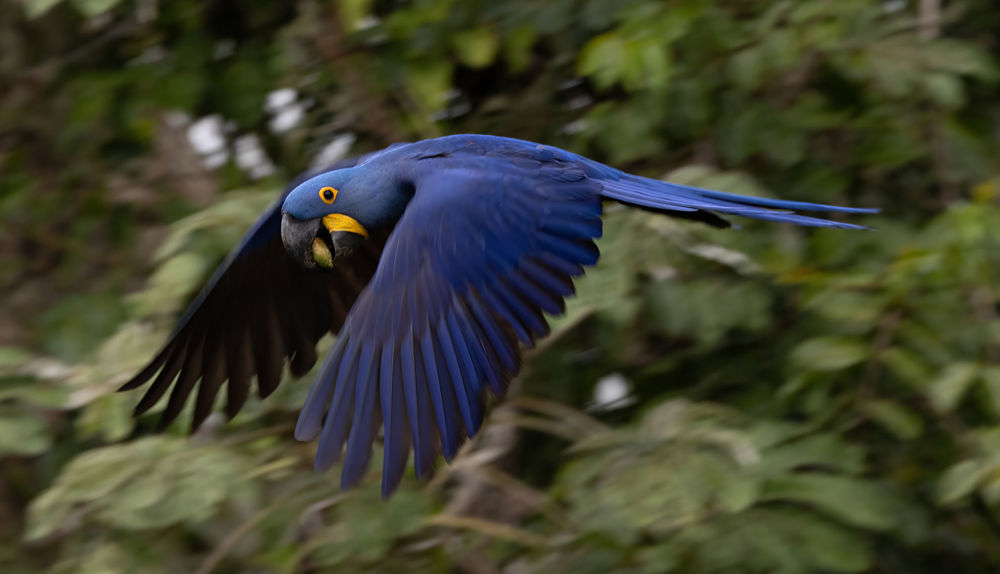
Hyacinth Macaw, Anodorhynchus hyacinthinus. Photo by D. Ascanio.
Our trip of a lifetime started with the short drive from Cuiaba to Posada Piuval, in the upper Pantanal, covered by tropical dry forest and scattered but still impressive wetlands. Right in front of the lodge, we were able to enjoy such unique birds as the Plumbeous Ibis, Pied Plover, Large-billed Tern, Jabiru, and Cocoi Heron. Passerine species also showed up in numbers, allowing us to tick the Yellow-billed Cardinal, Chopi Blackbird, and Rufous-bellied Thrush. A real highlight came the second afternoon, when a sudden strong wind induced an impressive number of Nacunda Nighthawks to take off from the ground.
A full day at Piuval Ranch allowed us to admire the beauty and elegance of the Red-legged Seriema, the grandeur of the Greater Rhea, the oddness of the Guira Cuckoo, and the beauty of the Hyacinth Macaw. Any of those birds alone would have made the tour a success, but it is the cumulative effect of so many superlatives that makes the Pantanal so special.
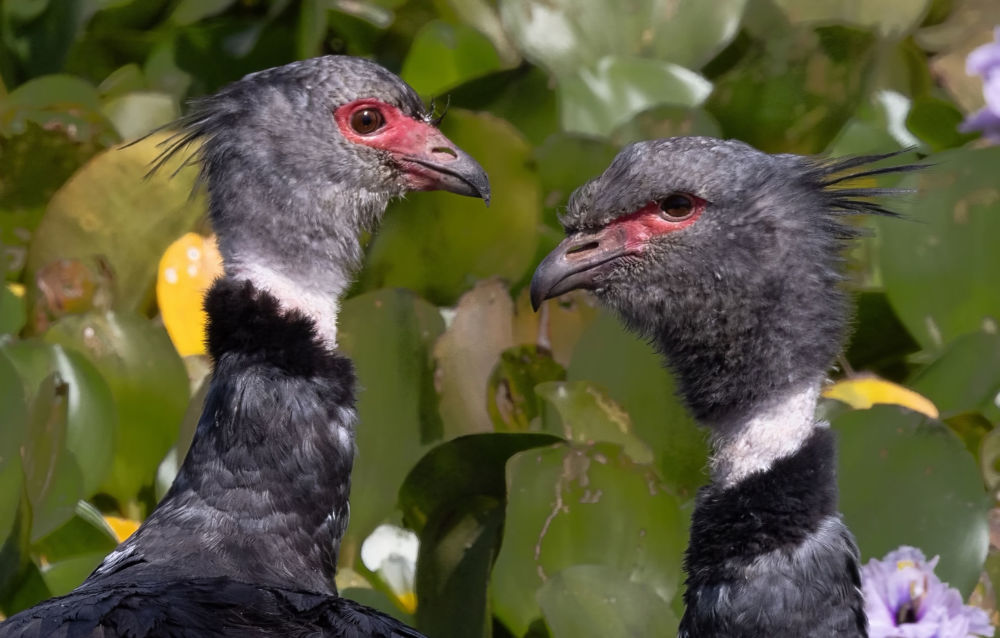
Northern Screamer, Chauna chavaria. Photo by D. Ascanio.
From Piuval Ranch, we headed south to another property where wildlife conservation is a priority. Under the leadership of the famous ornithologist Charlie Munn, Fazenda Santa Tereza has become a landmark in Pantanal wildlife watching. Scarcely had we arrived when we were already pointing out Marsh Deer, the largest cervid in South America, threatened by habitat loss. Over two full days in this wildlife Shangri-la, we added an impressive number of birds to our tally, eloquent testimony to the importance of this sanctuary.
A good indicator of habitat health in this part of the world is the presence of birds in the family Cracidae, comprising curassows, guans, and chachalacas. Members of these groups are among the first to disappear when their habitat is subjected to hunting or slash-and-burn agriculture. Here at Santa Tereza, though, we observed not one and not two, but five species of cracids: Chaco Chachalaca, Chestnut-bellied Guan, White-throated and Red-throated piping-guans, and Bare-faced Curassow, a species whose female I call “the love of my life.”
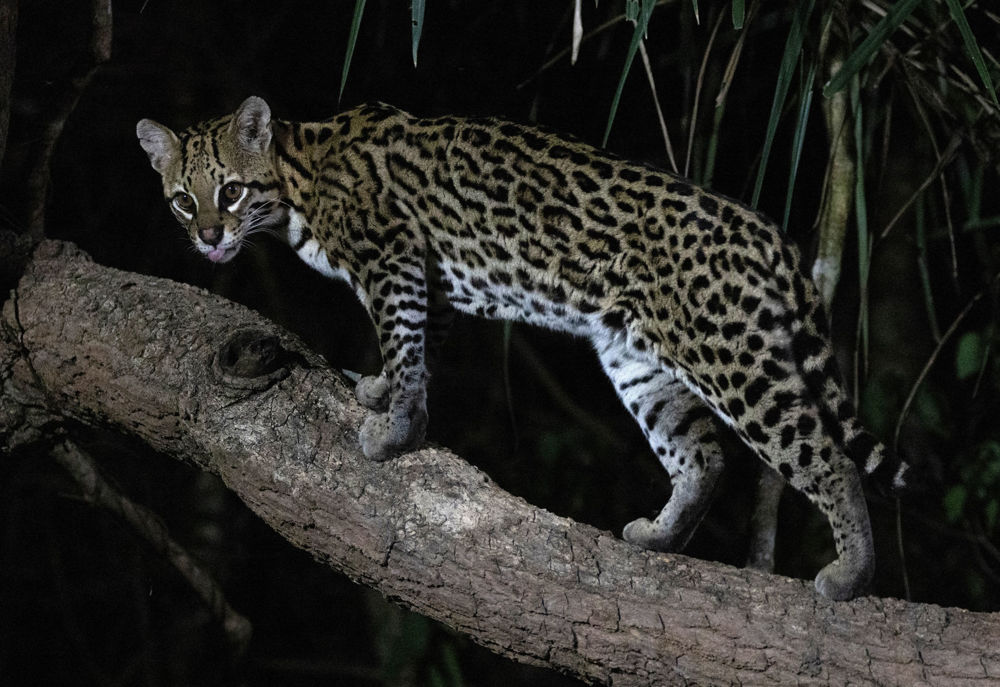
Ocelot, Leopardus pardalis. Photo by D. Ascanio.
From Santa Tereza, we continued our way south, to the location known as Jaguarland. The road itself presented a waterbird spectacle, with views of four species of ibis (Green, Bare-faced, Plumbeous, and Buff-necked) and ten species of egrets and herons. We also found a wonderful Sunbittern and enjoyed the astonishing rosette pattern of its wings in flight.
Our days in Jaguarland were a bit challenging, since a cold front had hit the area and wildlife activity dropped. On the positive side, this meant that we were spared the infamous extreme heat of the Pantanal. We had three full days to visit channels, rivers, and gallery forest. Despite the chill, these habitats gave us superb views of Bicolored Hawk, Blue-crowned Parakeet, and White, Little, and Golden-green woodpeckers. The most spectacular of all might have been the male Helmeted Manakin, a sighting that will remain a very special moment even if other memories fade with time.
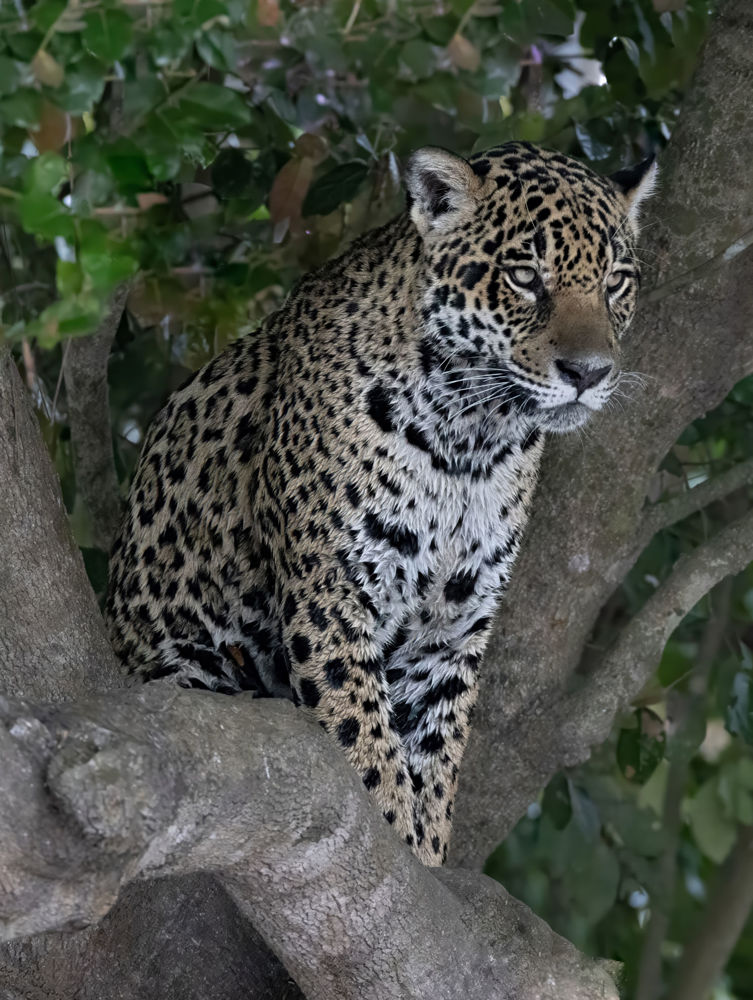
Jaguar, Panthera onca. Photo by D. Ascanio.
Birds, of course, weren’t the only reason to join this Pantanal mega-tour. Mammals made for great encounters as well. On one of our afternoons, we were astonished to see a tapir walking right in front of us. Later, in Jaguarland itself, we were lucky to have several encounters with the Giant Otter, an awesome experience. And there was more. On one cold afternoon, we took a long boat ride up the Pixaim River, where we observed the secretive and little-known Maned Wolf (video of this encounter is at instagram.com/reel/DLnsnibuajm/?igsh=ZzY3aWJlZWVieGo1).
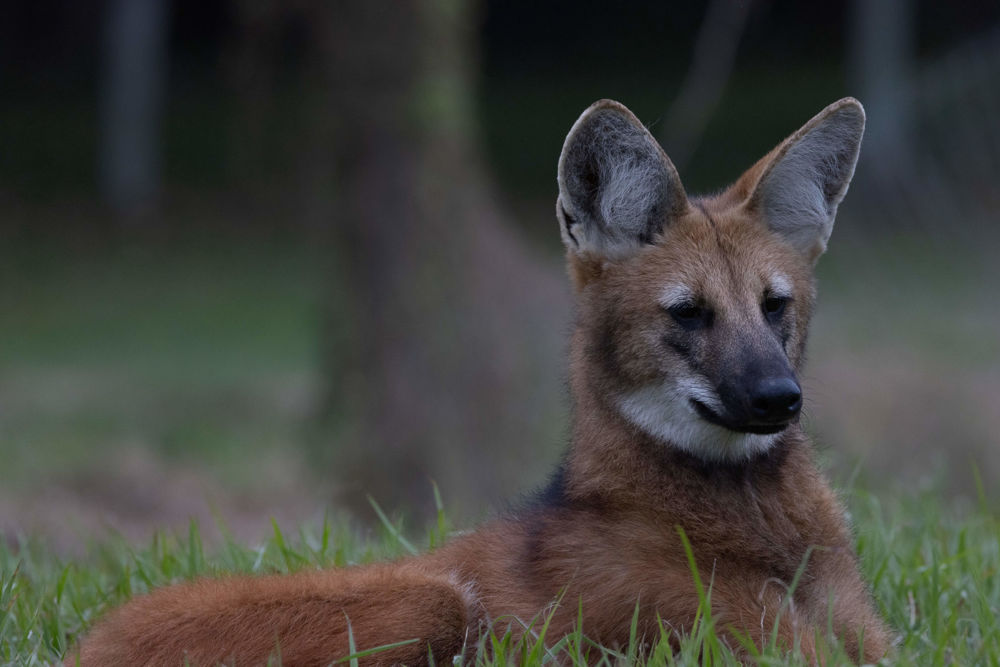
Maned Wolf, Chrysocyon brachyurus. Photo by David Ascanio.
Of course, we had come to the Pantanal to see Jaguars, and see them we did! We saw the couple known as Amber and Browser, Shy, another pair growling and mating, and the female called Ofelia. Best of all was the end of our last day. As we were heading back to the Floating Hotel, Liko stopped the boat and pointed at the riverbank. Yes, there was a resting male Jaguar, closing out—we thought—a day of magical encounters. But the magic continued after dinner, when Liko confirmed to us that that individual had not been reported before in the study area—and that we consequently had the right to name it. We spent the night in consideration of the options. The next morning, we had a decision: we voted unanimously to call him Victor, in honor of Victor Emanuel, VENT’s founder and a tireless conservationist who helped many people around the world protect birds and their habitats.
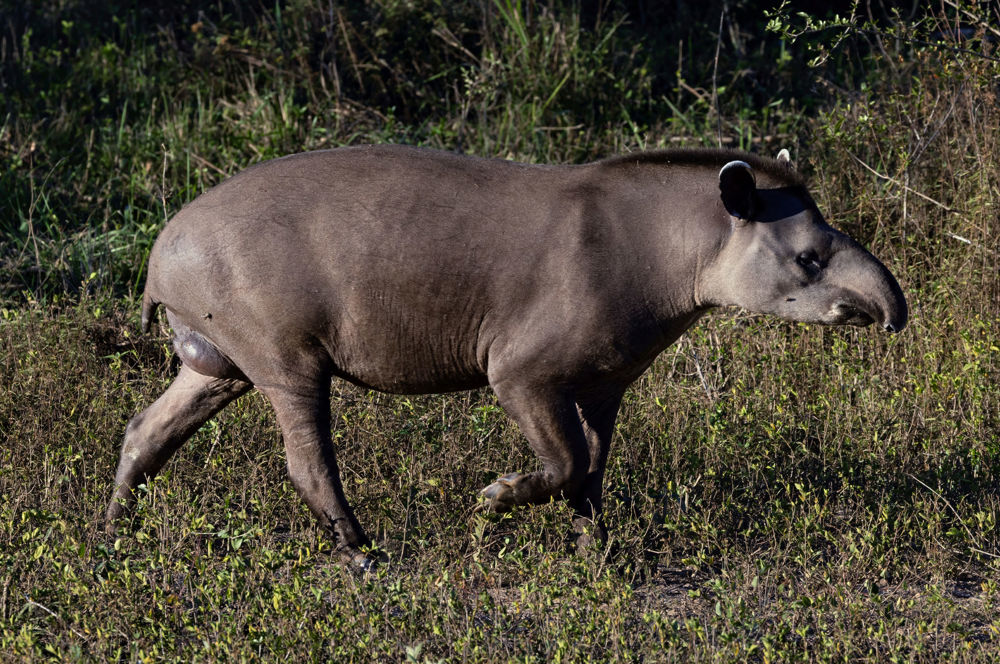
Brazilian Tapir, Tapirus terrestris. Photo by D. Ascanio.
Our encounter with the newly named Victor exceeded any of our expectations for this tour. Not only had we seen Jaguars, otters, a tapir, an Ocelot, and even a Maned Wolf, but we were able to leave behind us the imprint of a friend, a colleague, and a model of conservation.
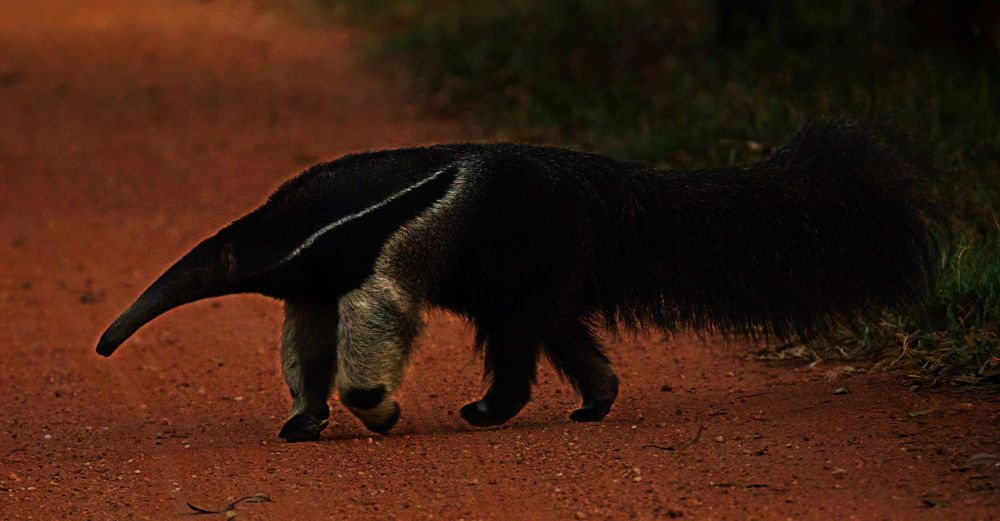
Giant Anteater, Myrmecophaga tridactyla. Photo by D Ascanio.
We headed back to Santa Tereza for one more night, then continued the next day to Cuiaba. Along the road we witnessed another miracle, a Giant Anteater foraging on the grasslands amid scattered trees. With that experience impressed on our memories, we completed our return journey secure in the conviction that we had visited a biome like none other on Earth. I am sure you will agree that the memories of this trip will stay with us for years to come.
A complete list of the birds recorded on our tour can be found at: https://ebird.org/tripreport/388766
Photo Album: https://www.flickr.com/photos/davidascanio/albums/72177720328854451

